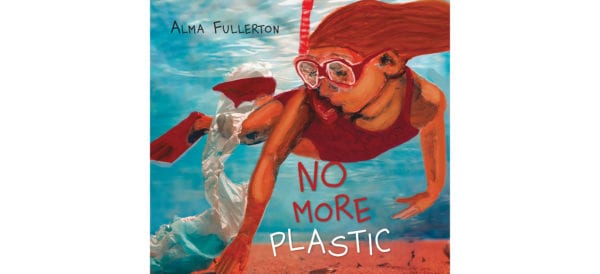
According to Rachel Salt, author and writer for the YouTube channel AsapSCIENCE, a staggering 6.3 metric tons of plastic – “equivalent to the mass of 42 million blue whales” – has been discarded over the course of human history. The global production of plastic has increased 190 times since 1950. This clearly amounts to an enormous environmental issue, which has reached a crisis point in 2021.
Ontario author and illustrator Alma Fullerton has long been passionate about environmental issues. Her concern about the effects of plastic waste on animal and human habitats led directly to her latest children’s book, No More Plastic, coming from Pajama Press in May.
An artistic innovator who enjoys working in mixed media, Fullerton has pulled off quite the feat in her new work, repurposing plastic waste to craft dioramas that comprise the book’s imagery. “I use a lot of recycled materials in my art anyway and I was just looking for something new to try because I never like doing the same thing over and over again,” Fullerton says.
The paper sculpture art for Fullerton’s book Community Soup consisted of objects found around the house; for a book about plastic waste, she thought that using the material for a beneficial purpose made sense. In No More Plastic, she used food containers, water bottles, and other waste to create images that were then painted and photographed.

Every aspect of the book’s illustrations is created from plastic except for the sand, which Fullerton imported from P.E.I. Fullerton used wire curtain rods from IKEA to string up birds and other objects. The result is visually stunning, though Fullerton says the process of creating the art was far from easy. “Painting on plastic is really hard. Layer and layer and layer to try to get the same consistency,” she says. “I tried to build a 3D whale and it just didn’t work well. So I did end up just cutting up plastic and sticking plastic on plastic and painting it.”
The plastic itself was sourced from colleagues and students at the school where Fullerton taught prior to COVID-19 lockdowns. Fellow teachers would bring in empty plastic fruit containers that Fullerton would incorporate into her artwork. Those fruit containers became the physical material used to build the human characters that appear in the book. “In some of them I didn’t paint on clothes but I would layer plastic bags over top of them.”
With its social message and innovative artistic approach, No More Plastic is both a passion project meant to teach children about the effects of plastic waste on the environment and an opportunity to highlight the potential of using found materials to create art. “I do that all the time,” Fullerton says. “When I do art workshops, we do collage and things like that. And I do it in the school I work in as well.”
 Contact us via email
Contact us via email
